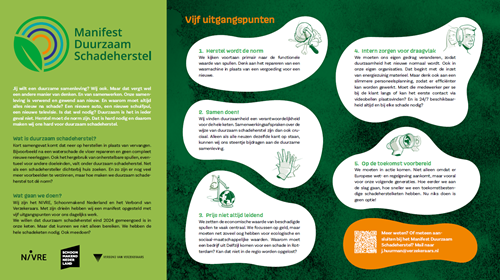Just before the summer of 2023, the Association has drawn up a manifesto. Together with Schoonmakend Nederland and NIVRE, the Association wants sustainable damage repair to be commonplace by the end of this year. How far along are insurers? What can they do? In this fifth and final part of our series, the story of Achmea.
It is clearly stated on the group's website: sustainability is decisive in everything we do. For example, in the event of a claim, Achmea always looks at how it can be solved as sustainably as possible. Often, repair is chosen instead of replacement. An example is spot repair. This means that in the event of minor damage, only the damaged part will be replaced.
Common property
Eva van Veen and Michiel Hondelink, together with some 235 colleagues, are involved in expertise, procurement and prevention on a daily basis. They dare to say that sustainable damage repair is already commonplace at Achmea. Hondelink: "That may sound arrogant, but if by sustainable damage repair you mean that you prefer to repair rather than replace, then we have been doing that for years. Repair provides convenience to the customer, because the damage is repaired much faster. It's also cheaper and sustainable."
What do insurers do?
This is the fifth and final part in our series on sustainable damage repair. In previous interviews, Ansvar, Midglas, Unigarant and Donatus have had their say.
Bodyshop Network
In addition, a large organisation can also make a lot of impact, Hondelink believes. "With our volumes, we can reach many customers. About 95 percent of our affiliated repairers in the home and car industry are already certified sustainable in some way. Think of ISO 14001, Certified Sustainable or Green Done. This means that the many thousands of damages are sustainably repaired through our repair network."
Nevertheless, Achmea also wants to continue working on a smarter, greener and better damage repair. "It's a great challenge," Van Veen emphasises. "This year, for example, we would like to come up with a good approach for determining the CO2 footprint for our recovery network. And, to be fair, it would help us and the entire sector enormously if we could jointly come up with a guideline, so that there is one standard."
"It would help us enormously if there was a common guideline"
Power of manifesto
Her colleague Hondelink hopes that this will also be the strength of the manifesto. "It's great that the Association, NIVRE and Schoonmakend Nederland have found each other in a manifesto. Joining forces is the only way to reach good agreements and, for example, to set standards for sustainable recovery. What can we do to make it even more sustainable?"
According to him, it is good news for the repair industry if insurers do not all reinvent the wheel in the future. "If one insurer demands x, while another wants y or z, we only drive each other up on costs. That's a shame and, in my opinion, unnecessary, because in the end we all have the same sustainable goal."

Role of the customer
The focus in the manifesto is on damage repair, but what is the role of the customer? And do insurers have a role in 'steering' that customer? Because what if that customer insists on new and doesn't feel like a recycled product? Or in spot repair? "It's a broad conversation that we're having at Achmea," says Van Veen. "How can we encourage customers to make even more use of our sustainable refinishers? And which materials can we use even more sustainably when repairing the damage? Or can we reuse materials? There are examples of countries in Europe that already use recycled parts as standard in the automotive market. We see great opportunities there, also for an individual to improve the footprint."
She wholeheartedly admits "that choices for recycling parts are a lot of work. Worldwide, more attention is being paid to sustainability and greening, but it goes without saying that we must be able to guarantee our customers adequate damage repair. "Thank you for bringing your car to us for repair. Because we like to use recycled parts, we will have a suitable bonnet for you in three months' time', cannot be the starting point."
"There are already examples of countries that use recycled parts as standard"
Prevention
Van Veen and Hondelink's message is clear. Sustainability goes beyond just that green colour. "With every contract we conclude, we ask you to sign the Achmea Sustainability Statement. Then it's also about how the company treats its staff, for example. Do they do safety training? What is the CSR policy? Green is important, but corporate social responsibility and prevention are also part of sustainability for us."
The latter, the prevention of damage, is and remains the best remedy, concludes Van Veen. "If you look at the emissions from large fires, you are shocked. Or, even worse, to the emissions from reconstruction, because that is even more severe for the environmental impact. We have once made a calculation of the emissions of a major fire. To compensate, you can put down a few football fields full of solar panels for that. I therefore believe that we can do even more in our sector in terms of prevention. Durability in the event of damage is really more than just repairing instead of replacing."
Sustainability at Achmea
Both Van Veen and Hondelink praise the space that Achmea offers its employees to think sustainably. "Of course, we also work with objectives to become more and more sustainable. Like other insurers, we are looking for more and better. For example, when it comes to 'measuring moisture remotely' and a digital intake when a damage is reported instead of driving somewhere. Or providing an ebike as a replacement vehicle."
But Achmea also wants to invest in making its staff greener. Each employee will therefore receive their own one-off climate budget (2,500 euros) for solar panels, the purchase of an energy-efficient washing machine, an electric bicycle or another 'green' wish. "A great initiative to get green even more into the DNA of the 12,000 employees," says Hondelink.
Was this article useful?


